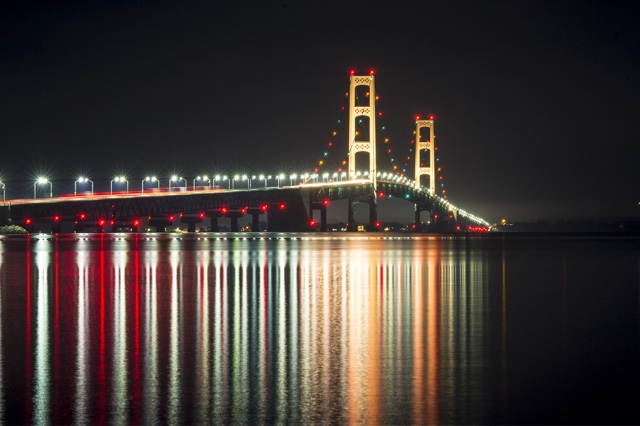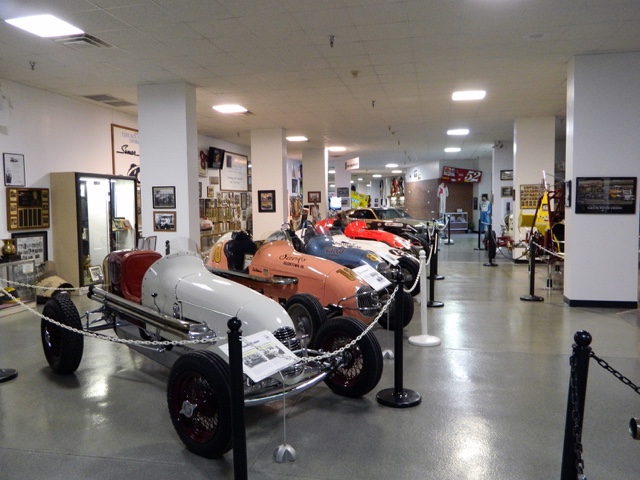Monday, September 28, 2015
Bridge Walk, St. Ignace and Mackinaw City, Michigan
Friday, September 25, 2015
Holt & Balcom Logging Camp, Lakewood, Wisconsin
Sunday, September 20, 2015
National Sprint Car Hall of Fame and Museum, Knoxville, Iowa
Let the fact about this museum be unfurled
It is the only museum dedicated to preserve the history of "big car" and sprint racing in the world
The National Sprint Car Hall of Fame & Museum, which is located on Iowa Highway 14 near Iowa Highways 5 & 92, is nearing its twenty-fifth full year of operation in 2016. The $1.7-million facility, situated on the Marion County Fairgrounds in Knoxville, officially opened on January 4, 1992. The educational museum is open seven days a week, year-round, with the following hours: 10 am – 6 pm, Monday through Friday; Noon – 5 pm, Saturday; and Noon – 5 pm, Sunday. Admission is four dollars per adult, three dollars per student or senior citizen, with children under the age of five being free. Group discounts are also available.
The first floor of the four-story structure features the Donald Lamberti National Sprint Car Museum, a museum store and the administrative offices. The museum currently has twenty-five (25) restored ‘big cars’, supermodifieds and sprint cars on loan. The 8,000-square-foot exhibit space also contains displays of trophies, paintings, photos, plaques, helmets and other memorabilia of the sport of sprint car racing.
The National Sprint Car Hall of Fame & Museum’s “Salute to Champion Doug Wolfgang” special exhibition, featuring seven of his actual race cars, is on display through November 15. This special exhibition, which follows similar ones honoring Tony Stewart (2011), Jeff Gordon (2012), Mario Andretti (2013) and Steve Kinser (2014), features an exclusive line of apparel in the on-line museum store at www.sprintcarstuff.com.
The top two floors of the National Sprint Car Hall of Fame & Museum facility provide outstanding views from turn number two of the legendary oval. The twenty skyboxes offer 400 patrons a unique setting in which to view the weekly sprint car racing action at Knoxville Raceway.
One Sprint Capital Place - P.O. Box 542
Knoxville, Iowa 50138
641-842-6176;
641-842-6177 (FAX);
sprintcarhof@sprintcarhof.com
http://www.sprintcarhof.com
Monday, September 14, 2015
Inland Aquatics, Terre Haute, Indiana
Specialties
We offer fish that live, aquariums that work, and water features that make your life easier, not harder.
We have the largest selection of tank-raised marine ornamentals on the planet. All of our wild-collected salt water fish are held for a minimum of 2-6 weeks, depending on species, before we offer them for sale, ensuring that we sell the most robust fish in the industry.
A lot of our stuff is raised right here in the building. Our facility is over 13,000 sq ft. and we have nearly 40,000 gallons of salt systems alone.
Inland Aquatics has been around since 1993 and is responsible for introducing refugia, deep sand beds, detritivores and Algal Turf Scrubbing to the hobby.
Our systems utilize ATScrubbers, which grow algae, remove wastes, oxygenate the system, and eliminate the need for monthly water exchanges!
Our staff members are aquarists with lots of experience and our general manager is a marine biologist.
Come check us out. You won't be disappointed.
History
Established in 1993.
Inland Aquatics was one of what was to be dozens of mariculture facilities, based on the paradigm outlined in Dr. Walter Adey's "Dynamic Aquaria". Algal Turf Scrubbing allowed us to operate inland and it was hoped that the plankton-friendly systems would allow us to overcome the "first food bottleneck" and raise dozens of new ornamental marine species.
Long story short... it didn't work. Nevertheless, our systems were incredibly healthy and we set out to revolutionize the aquarium hobby by introducing concepts such as refugiums, deep oolitic sand beds, Detritivore Kits, and Algal Turf Scrubbing to hobbyists.
Because we intended to breed new species, we spent an incredible amount of time and other resources attempting to obtain viable broodstock. This led to our discovery of Post Traumatic Shipping Disorder (PTSD) and the HUGE number of marine fish that are doomed to die many days or weeks after import. This is why we hold marine species for so long.
Meet the Manager
Morgan L, Manager
Morgan graduated from IU with an Honors Degree in Biology. Did independent research into he breeding behavior and teritorriality of cichlids and sticklebacks.
His plans to study at Texas A&M at Galveston were put on hold when he learned of the research of Dr. Walter Adey of the Smitsonian Institute of Natural History.
What was originally intended to be a small live-rock culturing project "in the basement" that would require minimal oversight, "on the weekends" quickly grew into the 13,000 sq foot facility that is now known as "Inland Aquatics."
Wednesday, September 9, 2015
Thunder Bay National Marine Sanctuary, Alpena, Michigan
A diver contemplates the practical bow of the Lucinda Van Valkenburg (1862–1887), a wooden schooner struck by the iron propeller Lehigh in May 1887. As a typical Great Lakes canal schooner, the Van Valkenburg’s bow was less sharp than ocean-going vessels whose design valued speed over cargo space. The centerboard trunk is just visible in the background—another construction feature adapted by Great Lakes shipwrights. The Van Valkenburg lies at a relatively shallow 60 feet; its masts stood out of the water when it first wrecked.
Photo: NOAA, Thunder Bay NMS.
The sheer size of the “fast-steel flyer” Norman(1890–1895) is evident in this striking photomosaic created by sanctuary archaeologists. The steel bulk freighter, with a net tonnage of 1,870, hauled thousands of tons of material in its short, five-year career. With the hull broken just forward of the boiler house and the ship listing hard to port, the wreck of the Norman, which claimed the lives of three sailors, is an intense dive experience.
Photo: NOAA, Thunder Bay NMS.
One of the ways sanctuary researchers work to preserve historic shipwrecks is through creating stunning photomosaics, like this one of the schooner Defiance (1848–1854). Future generations of recreational divers, explorers, and archaeologists are depending on us to leave historic shipwrecks intact. Enjoy diving the shipwrecks of Thunder Bay, but always respect the past. Removing or disturbing artifacts is illegal.
Photo: NOAA, Thunder Bay NMS.
A diver practice good buoyancy as they hover over the bow of the schooner E.B. Allen (1864–1871). With its heavy-duty windlass still on deck and anchor chains and rudder still in place, the Allen presents a vivid image of a typical nineteenth-century Great Lakes schooner.
Photo: NOAA, Thunder Bay NMS
Just below the surface of Lake Huron, a diver photographs the most recent shipwreck within current sanctuary boundaries—the German freighter Nordmeer (1954–1966). The site’s shallow depth (for many years, part of the vessel stood out of the water), and enormous size (almost 500 feet long), divers can enjoy lengthy bottom times as they explore the twisted steel hull.



































